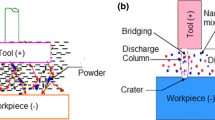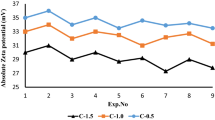Abstract
In the present work, an effort is made to evaluate the machining performance of the nano-powder mixed rotary electrical discharge machining (EDM) process by replacing the conventional EDM oil with environmentally friendly biodegradable Jatropha curcas oil (JCO). The performance of nano-powder mixed rotary EDM using JCO dielectric is compared with the conventional EDM process. Peak current, pulse on time, pulse off time, nano-powder concentration, and tool rpm are essential parameters to examine the material removal rate (MRR) and surface roughness (SR) of the EN-31 die steel. It is revealed from the results that the proposed modified EDM process shows a 73% improvement in MRR and 50% reduction in SR as compared to the conventional EDM process using EDM oil. Further, surface morphology, recast layer thickness (RLT) analysis, and microhardness analysis reveals that multi-wall carbon nanotube mixed rotary EDM using JCO shows small micro holes, no micro crack, smaller size debris deposition, lower RLT, and smaller microhardness of recast layer as compared to EDM oil. Finally, the sustainability indexes (SI) analysis result reveals that JCO is environmentally safe and economically justified due to a 9.92% lower SI value as compared to EDM oil.











Similar content being viewed by others
Data availability
The datasets used or analysed during the Machining process are available from the corresponding author upon reasonable request.
Abbreviations
- ANOVA:
-
Analysis of variance
- GA:
-
Genetic algorithm
- I p :
-
Peak current
- T on :
-
Pulse on time
- T off :
-
Pulse off time
- P c :
-
Powder concentration
- RSM:
-
Response surface methodology
- TR:
-
Tool rotation
- MRR:
-
Material removal rate
- TWR:
-
Tool wear rate
- SR:
-
Surface roughness
- MWCNT:
-
Multi-wall carbon nanotube
- MOO:
-
Multi-objective optimization
- FESEM:
-
Field emission scanning electron microscope
- RLT:
-
Recast layer thickness
- NPMEDM:
-
Nano powder mixed EDM
- SI:
-
Sustainability index
- JCO:
-
Jatropha curcas oil
- TOPSIS:
-
Technique for order preference by similarity to ideal solution
- GRA:
-
Grey relational analysis
References
Boothroyd G (1989) Non-conventional machining processes. In: Fundamentals of machining and machine tools. Marcel Dekker Inc, New York
Nanu D, Nanu A (2008) Perspectives of the dimensional processing through electric erosion processing. Nonconv Technol 3:61–64
Qin Y (2010) Micromanufacturing engineering and technology. William Andrew
Kiyak M, Çakır O (2007) Examination of machining parameters on surface roughness in EDM of tool steel. J Mater Process Technol 191(1–3):141–144
Karunakaran K, Chandrasekaran M (2017) Investigation of machine-ability of Inconel 800 in EDM with coated electrode. IOP Conf Ser Mater Sci Eng 183:012014
Muthuramalingam T, Mohan B, Jothilingam A (2014) Effect of tool electrode resolidification on surface hardness in electrical discharge machining. Mater Manuf Process 29(11–12):1374–1380
Zhang Q et al (2005) A theoretical model of surface roughness in ultrasonic vibration assisted electrical discharge machining in gas. Int J Manuf Technol Manag 7(2–4):381–390
Jafferson J, Hariharan P, Ram Kumar J (2014) Effects of ultrasonic vibration and magnetic field in micro-EDM milling of nonmagnetic material. Mater Manuf Process 29(3):357–363
Shabgard M, Farahmand M, Ivanov A (2009) Mathematical modelling and comparative study of the machining characteristics in ultrasonic-assisted electrical discharge machining of cemented tungsten carbide (WC-10% Co). Proc Inst Mech Eng Part B J Eng Manuf 223(9):1115–1126
Guu Y, Hocheng HJ (2001) Effects of workpiece rotation on machinability during electrical-discharge machining. Mater Manuf Process 16(1):91–101
Baseri H, Aliakbari E, Alinejad G (2012) Investigation of the rotary EDM process of X210Cr12. Int J Mach Mach Mater 11(3):297–307
Dhakar K, Dvivedi A (2016) Parametric evaluation on near-dry electric discharge machining. Mater Manuf Process 31(4):413–421
Singh NK, Pandey PM, Singh KK (2017) Experimental investigations into the performance of EDM using argon gas-assisted perforated electrodes. Mater Manuf Process 32(9):940–951
Baseri H, Sadeghian S (2016) Effects of nanopowder TiO2-mixed dielectric and rotary tool on EDM. Int J Adv Manuf Technol 83(1–4):519–528
Patel S, Thesiya D, Rajurkar A (2018) Aluminium powder mixed rotary electric discharge machining (PMEDM) on Inconel 718. Aust J Mech Eng 16(1):21–30
Kozak J, Rozenek M, Dabrowski L (2003) Study of electrical discharge machining using powder-suspended working media. Proc Inst Mech Eng Part B J Eng Manuf 217(11):1597–1602
Jeswani M (1981) Effect of the addition of graphite powder to kerosene used as the dielectric fluid in electrical discharge machining. Wear 70(2):133–139
Assarzadeh S, Ghoreishi M (2013) A dual response surface-desirability approach to process modeling and optimization of Al2O3 powder-mixed electrical discharge machining (PMEDM) parameters. Int J Adv Manuf Technol 64(9–12):1459–1477
Bhattacharya A, Batish A, Kumar N (2013) Surface characterization and material migration during surface modification of die steels with silicon, graphite and tungsten powder in EDM process. J Mech Sci Technol 27(1):133
Bhattacharya A, Batish A, Singh G (2012) Optimization of powder mixed electric discharge machining using dummy treated experimental design with analytic hierarchy process. Proc Inst Mech Eng Part B J Eng Manuf 226(1):103–116
Peças P, Henriques E (2008) Effect of the powder concentration and dielectric flow in the surface morphology in electrical discharge machining with powder-mixed dielectric (PMD-EDM). Int J Adv Manuf Technol 37(11–12):1120–1132
Prihandana GS et al (2011) Accuracy improvement in nanographite powder-suspended dielectric fluid for micro-electrical discharge machining processes. Int J Adv Manuf Technol 56(1–4):143–149
Jahan MP, Rahman M, San Wong Y (2011) Study on the nano-powder-mixed sinking and milling micro-EDM of WC-Co. Int J Adv Manuf Technol 53(1–4):167–180
Prabhu S, Vinayagam B (2011) AFM surface investigation of Inconel 825 with multi wall carbon nano tube in electrical discharge machining process using Taguchi analysis. Arch Civ Mech Eng 11(1):149–170
Mai C, Hocheng H, Huang S (2012) Advantages of carbon nanotubes in electrical discharge machining. Int J Adv Manuf Technol 59(1–4):111–117
Izman S et al (2012) Effects of adding multiwalled carbon nanotube into dielectric when EDMing titanium alloy. Adv Mater Res. https://doi.org/10.4028/www.scientific.net/AMR.463-464.1445
Sari MM, Noordin M, Brusa E (2013) Role of multi-wall carbon nanotubes on the main parameters of the electrical discharge machining (EDM) process. Int J Adv Manuf Technol 68(5–8):1095–1102
Prabhu S, Vinayagam B (2016) Optimization of carbon nanotube based electrical discharge machining parameters using full factorial design and genetic algorithm. Aust J Mech Eng 14(3):161–173
Mohal S, Kumar H (2017) Parametric optimization of multiwalled carbon nanotube-assisted electric discharge machining of Al-10% SiCp metal matrix composite by response surface methodology. Mater Manuf Process 32(3):263–273
Dwivedi AP, Choudhury SK (2016) Effect of tool rotation on MRR, TWR, and surface integrity of AISI-D3 steel using the rotary EDM process. Mater Manuf Process 31(14):1844–1852
Marashi H et al (2016) State of the art in powder mixed dielectric for EDM applications. Precis Eng 46:11–33
Valaki JB, Rathod PP (2016) Assessment of operational feasibility of waste vegetable oil based bio-dielectric fluid for sustainable electric discharge machining (EDM). Int J Adv Manuf Technol 87(5–8):1509–1518
Valaki JB, Rathod PP (2016) Investigating feasibility through performance analysis of green dielectrics for sustainable electric discharge machining. Mater Manuf Process 31(4):541–549
Valaki JB, Rathod PP, Sankhavara C (2016) Investigations on technical feasibility of Jatropha curcas oil based bio dielectric fluid for sustainable electric discharge machining (EDM). J Manuf Process 22:151–160
Long BT et al (2016) Optimization of PMEDM process parameter for maximizing material removal rate by Taguchi’s method. Int J Adv Manuf Technol 87(5):1929–1939
Nguyen H-P, Pham V-D, Ngo N-V (2018) Application of TOPSIS to Taguchi method for multi-characteristic optimization of electrical discharge machining with titanium powder mixed into dielectric fluid. Int J Adv Manuf Technol 98(5):1179–1198
Nguyen TD, Nguyen PH, Banh LT (2019) Die steel surface layer quality improvement in titanium μ-powder mixed die sinking electrical discharge machining. Int J Adv Manuf Technol 100(9):2637–2651
Banh T-L et al (2018) Characteristics optimization of powder mixed electric discharge machining using titanium powder for die steel materials. Proc Inst Mech Eng Part E J Process Mech Eng 232(3):281–298
HuuPhan N et al (2020) Influence of micro size titanium powder-mixed dielectric medium on surface quality measures in EDM process. Int J Adv Manuf Technol 109(3):797–807
Huu P-N (2020) Multi-objective optimization in titanium powder mixed electrical discharge machining process parameters for die steels. Alex Eng J 59(6):4063–4079
Taherkhani A et al (2021) Investigation of surface quality in cost of goods manufactured (COGM) method of μ-Al2O3 powder-mixed-EDM process on machining of Ti-6Al-4V. Int J Adv Manuf Technol 116(5):1783–1799
Bajaj R, Dixit AR, Tiwari AK (2020) Machining performance enhancement of powder mixed electric discharge machining using Green dielectric fluid. J Braz Soc Mech Sci Eng 42(10):1–20
Furutania K et al (2001) Accretion of titanium carbide by electrical discharge machining with powder suspended in working fluid. Precis Eng 25(2):138–144
Montgomery DC, Peck EA, Vining GG (2012) Introduction to linear regression analysis. Wiley, Hoboken
Kansal H, Singh S, Kumar P (2005) Parametric optimization of powder mixed electrical discharge machining by response surface methodology. J Mater Process Technol 169(3):427–436
Gill AS, Kumar S (2019) Surface characteristics investigation of tool steel machined by powder metallurgy tool in EDA. Mater Res Exp 6(12):1265b1
Pellegrini G, Ravasio C (2019) Evaluation of the sustainability of the micro-electrical discharge milling process. J Adv Prod Eng Manag 14(3):343–354
Moldavska A, Welo T (2017) The concept of sustainable manufacturing and its definitions: a content-analysis based literature review. J Clean Prod 166:744–755
Wang X et al (2018) Evaluation of EDM process for green manufacturing. Int J Adv Manuf Technol 94(1–4):633–641
Funding
This article does not involve any funding from any agency.
Author information
Authors and Affiliations
Contributions
All the authors have significantly contributed to prepare the article. Following is the contribution of individual Author: RB: Gap identification and conceptualization of the process along with all the experimental work. AKT: critical review and consolidation of write-up in proper format. AP: Data analysis of the manuscript. ARD: Conduction of experimentation. AKS: Formal analysis and data compilation.
Corresponding author
Ethics declarations
Conflict of interest
The authors declare no conflict of interest.
Ethical approval
This chapter does not contain any studies with human participants or animals performed by any of the authors. Authors acknowledge the work is original and all the relevant text from the literature has been properly cited.
Consent to participate
Authors agree to the authorship order.
Consent to publish
All authors have read and agreed to the published version of the manuscript.
Additional information
Technical Editor: Lincoln Cardoso Brandao.
Publisher's Note
Springer Nature remains neutral with regard to jurisdictional claims in published maps and institutional affiliations.
Rights and permissions
Springer Nature or its licensor (e.g. a society or other partner) holds exclusive rights to this article under a publishing agreement with the author(s) or other rightsholder(s); author self-archiving of the accepted manuscript version of this article is solely governed by the terms of such publishing agreement and applicable law.
About this article
Cite this article
Bajaj, R., Tiwari, A.K., Pramanik, A. et al. Machining performance and sustainability analysis of PMEDM process using green dielectric fluid. J Braz. Soc. Mech. Sci. Eng. 44, 563 (2022). https://doi.org/10.1007/s40430-022-03878-0
Received:
Accepted:
Published:
DOI: https://doi.org/10.1007/s40430-022-03878-0




